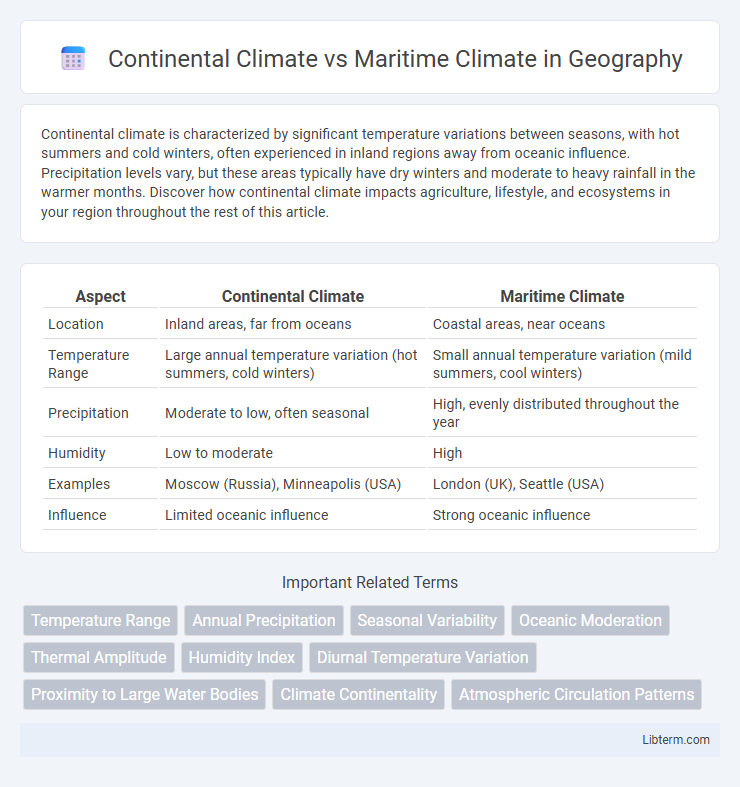Continental climate is characterized by significant temperature variations between seasons, with hot summers and cold winters, often experienced in inland regions away from oceanic influence. Precipitation levels vary, but these areas typically have dry winters and moderate to heavy rainfall in the warmer months. Discover how continental climate impacts agriculture, lifestyle, and ecosystems in your region throughout the rest of this article.
Table of Comparison
| Aspect | Continental Climate | Maritime Climate |
|---|---|---|
| Location | Inland areas, far from oceans | Coastal areas, near oceans |
| Temperature Range | Large annual temperature variation (hot summers, cold winters) | Small annual temperature variation (mild summers, cool winters) |
| Precipitation | Moderate to low, often seasonal | High, evenly distributed throughout the year |
| Humidity | Low to moderate | High |
| Examples | Moscow (Russia), Minneapolis (USA) | London (UK), Seattle (USA) |
| Influence | Limited oceanic influence | Strong oceanic influence |
Introduction to Climate Types
Continental climate is characterized by large temperature variations between summer and winter due to its location away from large water bodies, resulting in hot summers and cold winters. Maritime climate, influenced by proximity to oceans and seas, features moderate temperatures with smaller seasonal differences and higher humidity. Understanding these climate types is essential for predicting weather patterns, agriculture suitability, and ecosystem behavior in different regions.
Defining Continental Climate
Continental climate is characterized by significant temperature variations between seasons, with hot summers and cold winters due to its position away from large bodies of water that typically moderate temperature fluctuations. This climate type is commonly found in the interior regions of continents, such as central Asia, North America's Great Plains, and Eastern Europe, where landmass dominates over ocean influence. Low humidity and limited precipitation are typical, contributing to a stark contrast in seasonal weather patterns compared to maritime climates that experience milder, more stable conditions year-round.
Characteristics of Maritime Climate
Maritime climate features mild temperatures and high humidity with narrow temperature ranges due to oceanic influence, resulting in cool summers and mild winters. Precipitation is consistent year-round, often exceeding 1000 mm annually, fostering lush vegetation and stable ecosystems. Coastal regions with maritime climate benefit from moderated weather patterns and lower temperature extremes compared to continental climates.
Key Differences: Temperature Range
Continental climates exhibit a wider temperature range, often experiencing hot summers and cold winters due to their location far from large water bodies. Maritime climates have a narrower temperature range with milder summers and winters, influenced by proximity to oceans or seas that moderate temperature extremes. This leads to more stable and humid weather conditions in maritime regions compared to the more variable and dry conditions typical of continental areas.
Precipitation Patterns Compared
Continental climates experience highly variable precipitation, with most rainfall occurring during summer months due to convective thunderstorms, leading to distinct wet and dry seasons. Maritime climates exhibit more consistent precipitation throughout the year, often influenced by oceanic moisture and frequent frontal systems, resulting in moderate to high annual rainfall without pronounced seasonal extremes. The proximity to large water bodies in maritime regions moderates humidity and precipitation, while inland continental areas have lower humidity and more erratic rainfall patterns.
Seasonal Variations: Continental vs Maritime
Continental climates experience significant seasonal variations with hot summers and cold winters due to their distance from large water bodies, causing extreme temperature differences throughout the year. Maritime climates have mild seasonal variations with cooler summers and warmer winters, as ocean proximity moderates temperature fluctuations and increases humidity. This contrast in seasonal temperature ranges is a defining characteristic distinguishing continental and maritime climate zones.
Geographic Examples worldwide
Continental climates, characterized by greater temperature extremes and low humidity, are prominently found in interior regions such as Siberia, Central Asia, and the central United States. Maritime climates, exhibiting milder temperatures and higher humidity due to oceanic influence, prevail in coastal areas like Western Europe, including the UK and France, as well as the Pacific Northwest of the United States and Canada. These geographic distinctions shape local weather patterns, biodiversity, and agricultural practices.
Impact on Agriculture and Vegetation
Continental climates, characterized by greater temperature extremes and lower humidity, limit the growing season and stress crops due to frost risk and drought, impacting cereal and root crop productivity. Maritime climates exhibit milder temperatures and higher humidity, promoting longer growing seasons and more diverse vegetation, benefiting horticulture and pasture growth. Soil moisture retention and frost risk variation between these climates directly influence crop selection and agricultural yields.
Human Adaptations to Each Climate
Humans in continental climates often develop insulation-focused housing and clothing to withstand extreme temperature variations between scorching summers and frigid winters. In maritime climates, adaptations emphasize moisture resistance and moderate insulation due to more stable, humid conditions with mild temperature fluctuations. Agricultural practices also differ, with continental regions favoring crops resilient to temperature swings, while maritime areas support crops that thrive in consistent, moist environments.
Climate Change and Future Trends
Continental climates, characterized by large temperature variations and limited ocean influence, are projected to experience more extreme temperature increases due to climate change compared to maritime climates, which benefit from oceanic temperature regulation. Future trends indicate heightened drought frequency and intensified heatwaves in continental regions, while maritime climates may face increased precipitation and storm activity. Climate models consistently show amplified vulnerability for inland areas, emphasizing the need for adaptive strategies tailored to continental and maritime climate distinctions.
Continental Climate Infographic

 libterm.com
libterm.com